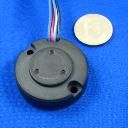Phoenix America Inc.
Magnetic Speed Sensors

Magnet Actuated Speed Sensors
The P1000 Series sensor is a non-contact, solid state device that is magnetically actuated for a variety of speed applications. The P1100 Series sensor is produced to a tight magnetic tolerance around the zero Gauss level to provide a 50% duty cycle over the operating full frequency range. With the additional advantage of low hysteresis, this device is ideal for operation with high-density multi-pole magnet target wheels and large air gap applications, along with providing the position repeatability needs for motor commutation applications. It is capable of reading speeds from zero to 100 kHz.
Features:
- Digital Output Signal
- 4-24 VDC Operation Range
- Current Sinking Output
- Reverse Polarity Protection
- 0 to100 kHz Operation
- Temperature Compensated
- Operation from –40°C to 125°C
- Rugged, thermoplastic housing
Gear Actuated Speed Sensors
The Series P5000 Hall Effect Gear Tooth speed sensor is a non-contact, solid state ferrous detecting device with a switched output. Its unique design provides a low cost solution for a wide range of speed sensing applications, especially those requiring true zero speed performance. This device utilizes a Hall Effect sensor that is internally biased with a Rare Earth permanent magnet and detects the interaction from an external ferrous target. Unlike earlier Hall based products, this device automatically detects changes in target position or symmetry and “self adjusts” to compensates for these changes. This specialized feature eliminates the need to externally calibrate or mechanically adjust each sensor for optimum performance. In addition, electronic hysteresis built into the device eliminates false triggering due to mechanical backlash and vibration. Installation of this sensor is also easier than “dual element” versions as this device operates correctly regardless of its rotational position or alignment relative to the motion of the target.
Features:
- Digital Output Signal
- Gear Tooth Sensing Capability
- No Rotary Orientation Concerns
- Operation from -40-125 Degrees C
- Short Circuit Protection
- Zero Speed Operation
- High Speed (15 kHz) Operation
- 6.3 - 24 VDC Operation
Variable Reluctance Sensors:
Variable-reluctance sensors are preferred for industrial and automotive environments, because they sustain mechanical vibration and higher temperature operation. In most applications, they sense a steel target that is part of a rotating assembly. Because the unprocessed signal amplitude is proportional to the target speed, a sensor whose signal-processing circuitry is designed for high speed ceases to function at some lower rate of rotation.
Variable Reluctance sensors are often referred to a ‘passive’ magnetic sensor because it does not need to be powered. Variable Reluctance sensors are ‘self generating’.
The variable reluctance wheel speed sensor is basically a permanent magnet with wire wrapped around it. It is usually a simple circuit of only two wires where in most cases polarity is not important. The physics behind the operation include magnetic induction.
A toothed ring on the wheel passes by the speed sensor and disrupts the magnetic field. The disruption in the field causes the wheel speed sensor to produce a sinusoidal (AC) voltage signal. The frequency and amplitude of the AC voltage signal are proportional to the speed of the wheel. The amplitude of the wheel speed signal is also directly related to the distance between the wheel speed sensor coil and the toothed ring. The distance is referred to as the air gap. This gap is critical to ensure AC output at lower speeds.
It is important to remember that air gap can change on a vehicle with loose wheel bearings or worn parts. Improper air gap can cause what is called sensor dropout. This can occur when the sensor will not produce output at lower speeds. This situation was found on some vehicles with an electronic speedometer. The customer would complain that while slowing to a stop, the speedometer would "drop off" or return to zero, maybe at around 8 to 10 mph. Too large of an air gap was the problem.
Benefits
- Low cost, robust proven speed and position sensing technology.
- Self-generating electrical signal requires no external power supply.
- Fewer wiring connections contribute to excellent reliability.
- Meets a wide range of output, resistance, and inductance requirements so the sensor can be tailored to meet specific customer requirements.
Click here for more Product Details from
Phoenix America Inc....